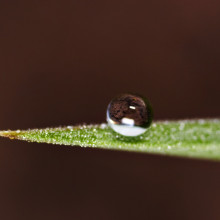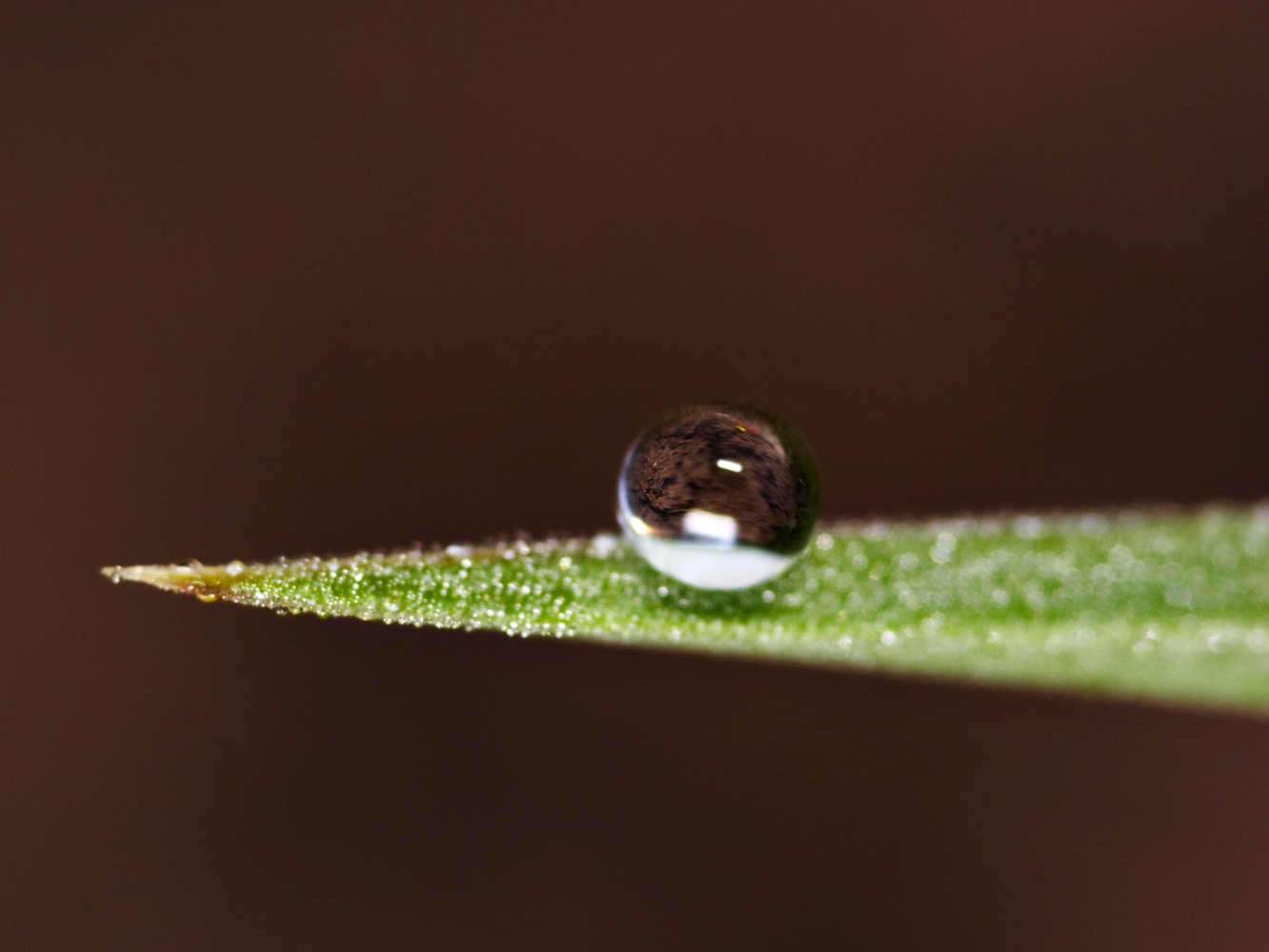In this week's NewsFlash, we find out how a new technique can make waterproof coatings that survive the wash, why pancreatic cancer is hard to spot and how one in five Sun-like stars may have Earth like planets. Plus, a new graphene based transistor amplifier, and how thinking of Marilyn Monroe can give us insights into the brain...
In this episode

00:28 - Super-Waterproof Cotton
Super-Waterproof Cotton
Waterproof clothing has got a lot more comfortable over the last 20 years with the invention of various breathable fabrics. One common strategy is to make the fabric super hydrophpbic or very very water repellant, this means that despite the fact that it is covered with holes so water vapour from sweat can escape, water  droplets can't get through because they are bigger than the holes. The bigger the holes the more breathable the fabric is, but to stay waterproof, you also need to make the fabric more hydrophobic. While there are superhydrophobic coatings which could make a sieve reasonably waterproof, the problem is that most of the hydrophobic coatings are not especially robust, and whilst your coat might be very water repelant when it is new, if you wash it, you also wash off the water repellancy.
droplets can't get through because they are bigger than the holes. The bigger the holes the more breathable the fabric is, but to stay waterproof, you also need to make the fabric more hydrophobic. While there are superhydrophobic coatings which could make a sieve reasonably waterproof, the problem is that most of the hydrophobic coatings are not especially robust, and whilst your coat might be very water repelant when it is new, if you wash it, you also wash off the water repellancy.
Bo Deng and collegues at the Shanghai institute of applied physics have been working on this, they took a commercially available super-hydrophobic coating, a heavily fluorinated acrylate polymer. Instead of adding some kind of catalyst to cause the acrylate monomer to form a polymer they irradiated cotton soaked in a solution of the monomer with gamma rays. Sometimes a gamma ray will hit the cotton, break some bonds in the cotton and allow the polymer to to start forming at this pont. This means that the polymer molecules are strongly bonded to the cotton.
The fabrics they produce will allow a droplet of water to roll around the surface without wetting it at all, and more impressively will keep this property after the equivalent of 250 washes.
As well as making great coats, they suggest that the cotton might be useful in floatation devices as if you made the filling of a lifejacket, or even a fisherman's coat or shirt, out of this superhydrophobic cotton, it would repel water, and so be covered with a layer of air and so produce significant floatation if you fell in the water.

04:09 - Pancreatic cancer takes ten years to spread
Pancreatic cancer takes ten years to spread
Scientists studying tumour samples pancreatic cancer victims have made a surprising discovery - the disease appears to take a very long time to develop before it begins to spread.
The prognosis for pancreatic malignancies is almost universally dire with a 5 year survival rate of about 5-10%. This is because the disease tends to reveal itself very late, by which time the tumour has often already spread - metastasised - to other tissues.
 But this grim outcome could be improved thanks to a new study published in the journal Nature and carried out by Johns Hopkins-based scientist Christine Iacobuzio-Donahue and her colleagues. This team obtained fresh autopsy tissue from 7 patients who had died from pancreatic cancer.
But this grim outcome could be improved thanks to a new study published in the journal Nature and carried out by Johns Hopkins-based scientist Christine Iacobuzio-Donahue and her colleagues. This team obtained fresh autopsy tissue from 7 patients who had died from pancreatic cancer.
By extracting viable cells and DNA from the tumour deposits in these patients, including from both the primary pancreatic tumour and the metastases, the researchers were able to build an evolutionary tree tracing the acquisition of the DNA mutations that triggered the tumours and then the disease spread. The bulk of the DNA damage linked to the disease, they found, was already present in the primary tumour, and they could trace "sub-clones" of the primary that had given rise to different metastatic events around the body.
This result shows that, contrary to prevailing wisdom - that potentially cancerous cells spread early and then turn into tumours later - does not apply to pancreatic cancer. Moreover, using mathematical algorithms to track the rate of disease progression, the team were able to determine that it takes on average 11.7 years before the first cancer cell develops within a high grade lesion, then a further 7 years before the cancer the potential to spread and, finally, about 2 and a half years from then until a patient's death. This suggests that early detection and early intervention could dramatically improve what is currently an appalling prognosis.

07:50 - One in Five Sun-like stars have Earth-like Planets
One in Five Sun-like stars have Earth-like Planets
Dr Andrew Howard, University of California, Berkely
Chris - Also this week, we have heard good news that we may not be alone or at least, not so lonely in the universe as we maybe first thought because researchers in America have announced that as many as 23% of stars like our Sun could have Earth-sized planets orbiting around them. To explain how they came to this figure and what it means for the search for other worlds a bit like our own, we're joined now by Dr. Andrew Howard who is at the University of California at Berkeley. Hello, Andrew.
Andrew - Hello.
Chris - Andrew, tell us first of all, how did you actually do this study?
 Andrew - So we used the Keck telescope in Hawaii and essentially what we did was conduct a census of the planets orbiting the stars nearest to our own solar system. We looked at each one of the 166 stars night after night for almost 5 years. We didn't look at them every single night but we were able to detect the most massive planets - those planets that are even bigger than Jupiter- as well as less-massive planets - those planets that were down to a mass of about 3 times the mass of the Earth. So we covered this enormous mass range from 3 Earth masses, all the way up to a thousand Earth masses. We can't quite detect the Earths, which we'd really like to, but we can extrapolate their numbers based on a really clear trend that we see from having relatively few planets. At the high mass end, we see only about 1 or 2 Jupiters per 100 stars in our survey. Down at the low mass end, we see a lot more planets in the 3 to 10 Earth mass range. We see something like 12 planets per 100 stars. And so, if you just extrapolate this trend that we see over a very large mass rates down to one Earth mass planets, we estimate that about 23% of stars like the sun have a relatively close-in planet like the Earth.
Andrew - So we used the Keck telescope in Hawaii and essentially what we did was conduct a census of the planets orbiting the stars nearest to our own solar system. We looked at each one of the 166 stars night after night for almost 5 years. We didn't look at them every single night but we were able to detect the most massive planets - those planets that are even bigger than Jupiter- as well as less-massive planets - those planets that were down to a mass of about 3 times the mass of the Earth. So we covered this enormous mass range from 3 Earth masses, all the way up to a thousand Earth masses. We can't quite detect the Earths, which we'd really like to, but we can extrapolate their numbers based on a really clear trend that we see from having relatively few planets. At the high mass end, we see only about 1 or 2 Jupiters per 100 stars in our survey. Down at the low mass end, we see a lot more planets in the 3 to 10 Earth mass range. We see something like 12 planets per 100 stars. And so, if you just extrapolate this trend that we see over a very large mass rates down to one Earth mass planets, we estimate that about 23% of stars like the sun have a relatively close-in planet like the Earth.
Chris - That's a big number, isn't it?
Andrew - Twenty three is a really big number. This number has sometimes been called Eta of Earth for the Greek character Eta. This is a term that's appeared in Frank Drake's equation that's used to estimate the prospects for SETI. And Eta of Earth had remained kind of a mystery. People always wanted to know, are Earth-like planets common or are they rare and some people estimated that it was 100%. Some people estimated that it was one in a million. We say 23% or about 1 in 4 and to be fair, we had a little bit of an extrapolation here, and I wouldn't be surprised if the true number is 1 in 2 or maybe in 1 in 8, but it's not 1 in 100, and that's a really big improvement in our knowledge.
Chris - If we could visit some of these distant worlds, what would they be like? What are the prospects that they're in the same position, relative to their star, that our Earth is and therefore, have the kinds of conditions that this planet does - in other words, it's not too hot, not too cold, we've got liquid water?
Andrew - The technique we used is the Doppler method, sometimes called the Wobble method, and it turns out that we're most sensitive to planets that are really close to their host stars. So we were only able to detect planets out to a quarter of the Earth-sun distance. So at that really close orbital distance which is, if you put the planets inside the solar system, they'd be inside the orbit of Mercury. These are really hot planets. I really seriously doubt that there's life on these specific planets, but what they tell us is that nature makes small planets commonly and deposits them at close orbital distances, and it seems reasonable to suppose that if there are planets at close orbital distances, there are probably planets a little farther out where the radiation from the Sun isn't so intense and these planets might be in the so-called Goldilocks zone or the habitable zone of planets where the temperature is not too hot, not to cold. It's just right for liquid water and perhaps, for life to evolve.
Chris - How does this finding sit with our understanding of how systems like our own do put themselves together and evolve in the first place?
 Andrew - It's really interesting that these so-called theories of planet formation, there's this dominant paradigm which is called the core accretion model. This is a model that's been long-standing, and it predicts that most planets in all solar systems are born in the cool outer reaches far from the host star. And the main reason is because, to efficiently make the core of a planet, you need ice and to have ice, you have to be in a cooler part of the solar system, that it's far from the host star. So this model predicts that most planets are born out there. Some of them grow up to be quite large, the size of Saturns and Jupiters, and some do not. Some are a whole range of sizes - from smaller than the Earth to Earth-size to a little bit bigger, but the theory also predicts that it's basically only the largest planets, the gas giants like Saturn and Jupiter that migrate close to their host star. So this theory made a prediction for our observations and they predicted that we would only detect large close-in planets, and we shouldn't detect very many small close-in planets. And they actually had a name for this. The theorists called this The Planet Desert. They predicted there'd be almost no close-in small planets.
Andrew - It's really interesting that these so-called theories of planet formation, there's this dominant paradigm which is called the core accretion model. This is a model that's been long-standing, and it predicts that most planets in all solar systems are born in the cool outer reaches far from the host star. And the main reason is because, to efficiently make the core of a planet, you need ice and to have ice, you have to be in a cooler part of the solar system, that it's far from the host star. So this model predicts that most planets are born out there. Some of them grow up to be quite large, the size of Saturns and Jupiters, and some do not. Some are a whole range of sizes - from smaller than the Earth to Earth-size to a little bit bigger, but the theory also predicts that it's basically only the largest planets, the gas giants like Saturn and Jupiter that migrate close to their host star. So this theory made a prediction for our observations and they predicted that we would only detect large close-in planets, and we shouldn't detect very many small close-in planets. And they actually had a name for this. The theorists called this The Planet Desert. They predicted there'd be almost no close-in small planets.
Chris - But instead you've detected an oasis there, haven't you? You've got a whole lot of them. One in four of them have got small planets.
Andrew - It's a tropical rainforest. It's the opposite of a desert. So, I think the whole theory of planet formation by core accretion, I don't think it needs to be thrown out, but I think that in particular, this migration part of it is not right and it needs to be revised.

13:29 - New form of transistor developed
New form of transistor developed
Almost all analog electronics, from cassette players to the radio parts of mobile phones, are based around transistor amplifiers. These are circuits based on transistors which will take an input signal and amplify the voltage or the current to produce a much larger output.
 There are 2 main types of amplifier: Positive gain, where if you increase the input you increase the output; and negative gain, where if you increase the input the output decreases. These both involve different physical types of transistor, so if you want an amplifier to do both the circuit you need gets much more complex.
There are 2 main types of amplifier: Positive gain, where if you increase the input you increase the output; and negative gain, where if you increase the input the output decreases. These both involve different physical types of transistor, so if you want an amplifier to do both the circuit you need gets much more complex.
Xuebei Yang and colleagues from Rice University in Houston has been working on transistors made form graphene, the promising material that consists of a single layer of carbon. The transistors they have built change their behaviour entirely depending on the bias voltage you apply to them, changing from positive gain to negative gain, through an intermediate frequency doubling state.
This could make simple amplifiers slightly more flexible but they say that it could have a much bigger effect on transmitters that encode the signal in the frequency or the phase of the signal, plus whatever the very innovative electronic engineers can come up with. Ultimately, this technology could lead to smaller, cheaper and possibly more power efficient mobile phones and other radio devices. Also, as graphene has very good high frequency properties, they could work a lot faster than the present ones!

15:34 - Thinking along the right lines
Thinking along the right lines
In a study that informs our understanding of how the brain allocates attention to different stimuli, scientists have successfully enabled human volunteers to choose between images on a computer screen just by altering their thoughts...
Writing in Nature, Caltech-based researcher Moran Cerf and his colleagues describe how they recruited 12 epileptic patients who were undergoing brain studies to identify the sources of their seizures.
Arrays of 64 electrodes had been temporarily implanted into the medial temporal lobes of the patients to monitor brain activity. The researchers showed the subjects over 100 images of familiar people, places, animals and buildings including Marilyn Monroe and Bill Clinton. Four electrodes that registered nerve cell activity exclusively when a subject viewed a specific image were then identified.
Next, in a thirty minute trial, the subjects were shown combinations of the four images with two of them superimposed in a semi-transparent manner on a screen, one in front of the other. A computer was programmed to monitor the output from the electrodes and to increase the visibility (opacity) of an image when the electrode to which it was linked detected more brain activity.
In each trial, the subjects were then instructed to try to make one of the two images more visible and fade out the other, by whatever thought processes they wished.Incredibly, in 69% of cases, and with no prior training, the subjects were able to manipulate the computer image, with half of them reporting that they just "concentrated on the face they were interested in".
Intruigingly, the setup also allowed the team to probe the process of attention. They had expected that, when a subject was instructed to focus on, say, Marilyn Monroe, the electrode corresponding to her picture would become more active. Instead, the non-Marilyn Monroe electrodes became less active. In this way the brain is clearly focusing attention by reducing the level of distraction, almost like focusing the beam of a spotlamp on one part of a drama unfolding on stage.
And apart from academic interest, the new technique may be useful from a practical perspective since it might be possible to design a system to help paralysed patients to regain control over their environment. "We could actually learn how their brain looks when they think of water, food, or pain," says Cerf. This would allow a patient to communicate with doctors again.









Comments
Add a comment